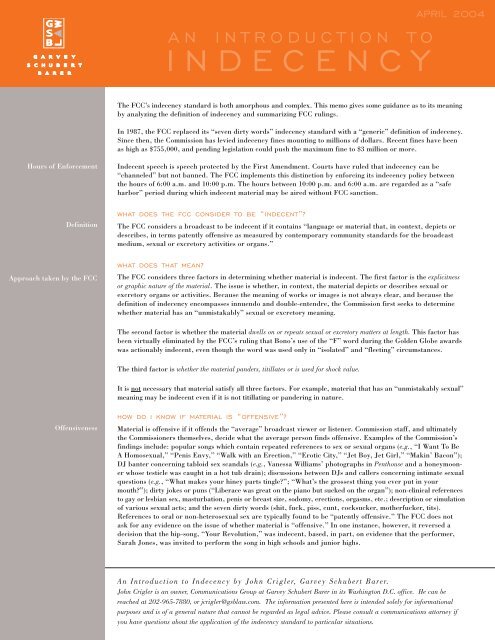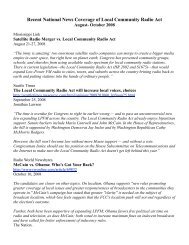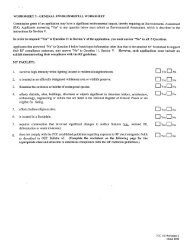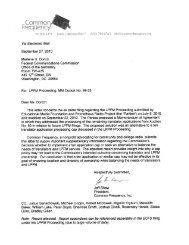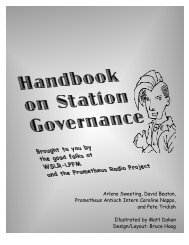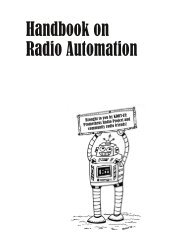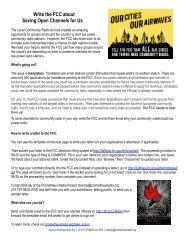WSCA Station Handbook and Training Manual - Prometheus Radio ...
WSCA Station Handbook and Training Manual - Prometheus Radio ...
WSCA Station Handbook and Training Manual - Prometheus Radio ...
You also want an ePaper? Increase the reach of your titles
YUMPU automatically turns print PDFs into web optimized ePapers that Google loves.
AN INTRODUCTION TO<br />
INDECENCY<br />
APRIL 2004<br />
The FCC’s indecency st<strong>and</strong>ard is both amorphous <strong>and</strong> complex. This memo gives some guidance as to its meaning<br />
by analyzing the definition of indecency <strong>and</strong> summarizing FCC rulings.<br />
In 1987, the FCC replaced its “seven dirty words” indecency st<strong>and</strong>ard with a “generic” definition of indecency.<br />
Since then, the Commission has levied indecency fines mounting to millions of dollars. Recent fines have been<br />
as high as $755,000, <strong>and</strong> pending legislation could push the maximum fine to $3 million or more.<br />
Hours of Enforcement<br />
Definition<br />
Approach taken by the FCC<br />
Indecent speech is speech protected by the First Amendment. Courts have ruled that indecency can be<br />
“channeled” but not banned. The FCC implements this distinction by enforcing its indecency policy between<br />
the hours of 6:00 a.m. <strong>and</strong> 10:00 p.m. The hours between 10:00 p.m. <strong>and</strong> 6:00 a.m. are regarded as a “safe<br />
harbor” period during which indecent material may be aired without FCC sanction.<br />
WHAT DOES THE FCC CONSIDER TO BE “INDECENT”?<br />
The FCC considers a broadcast to be indecent if it contains “language or material that, in context, depicts or<br />
describes, in terms patently offensive as measured by contemporary community st<strong>and</strong>ards for the broadcast<br />
medium, sexual or excretory activities or organs.”<br />
WHAT DOES THAT MEAN?<br />
The FCC considers three factors in determining whether material is indecent. The first factor is the explicitness<br />
or graphic nature of the material. The issue is whether, in context, the material depicts or describes sexual or<br />
excretory organs or activities. Because the meaning of works or images is not always clear, <strong>and</strong> because the<br />
definition of indecency encompasses innuendo <strong>and</strong> double-entendre, the Commission first seeks to determine<br />
whether material has an “unmistakably” sexual or excretory meaning.<br />
The second factor is whether the material dwells on or repeats sexual or excretory matters at length. This factor has<br />
been virtually eliminated by the FCC’s ruling that Bono’s use of the “F” word during the Golden Globe awards<br />
was actionably indecent, even though the word was used only in “isolated” <strong>and</strong> “fleeting” circumstances.<br />
The third factor is whether the material p<strong>and</strong>ers, titillates or is used for shock value.<br />
It is not necessary that material satisfy all three factors. For example, material that has an “unmistakably sexual”<br />
meaning may be indecent even if it is not titillating or p<strong>and</strong>ering in nature.<br />
Offensiveness<br />
HOW DO I KNOW IF MATERIAL IS “OFFENSIVE”?<br />
Material is offensive if it offends the “average” broadcast viewer or listener. Commission staff, <strong>and</strong> ultimately<br />
the Commissioners themselves, decide what the average person finds offensive. Examples of the Commission’s<br />
findings include: popular songs which contain repeated references to sex or sexual organs (e.g., “I Want To Be<br />
A Homosexual,” “Penis Envy,” “Walk with an Erection,” “Erotic City,” “Jet Boy, Jet Girl,” “Makin’ Bacon”);<br />
DJ banter concerning tabloid sex sc<strong>and</strong>als (e.g., Vanessa Williams’ photographs in Penthouse <strong>and</strong> a honeymooner<br />
whose testicle was caught in a hot tub drain); discussions between DJs <strong>and</strong> callers concerning intimate sexual<br />
questions (e.g., “What makes your hiney parts tingle?”; “What’s the grossest thing you ever put in your<br />
mouth?”); dirty jokes or puns (“Liberace was great on the piano but sucked on the organ”); non-clinical references<br />
to gay or lesbian sex, masturbation, penis or breast size, sodomy, erections, orgasms, etc.; description or simulation<br />
of various sexual acts; <strong>and</strong> the seven dirty words (shit, fuck, piss, cunt, cocksucker, motherfucker, tits).<br />
References to oral or non-heterosexual sex are typically found to be “patently offensive.” The FCC does not<br />
ask for any evidence on the issue of whether material is “offensive.” In one instance, however, it reversed a<br />
decision that the hip-song, “Your Revolution,” was indecent, based, in part, on evidence that the performer,<br />
Sarah Jones, was invited to perform the song in high schools <strong>and</strong> junior highs.<br />
An Introduction to Indecency by John Crigler, Garvey Schubert Barer.<br />
John Crigler is an owner, Communications Group at Garvey Schubert Barer in its Washington D.C. office. He can be<br />
reached at 202-965-7880, or jcrigler@gsblaw.com. The information presented here is intended solely for informational<br />
purposes <strong>and</strong> is of a general nature that cannot be regarded as legal advice. Please consult a communications attorney if<br />
you have questions about the application of the indecency st<strong>and</strong>ard to particular situations.


